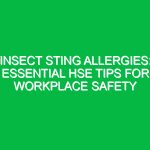Introduction
The exclamation mark hazard symbol, often represented as a yellow triangle with a black exclamation mark inside, serves as a crucial visual warning in the Health, Safety, and Environment (HSE) domain. This symbol alerts individuals to potential Hazards that may not be immediately obvious but can pose risks to health and Safety. Understanding this symbol’s significance is vital for anyone working in environments where Safety is paramount, such as construction sites, chemical plants, and laboratories.
In this Comprehensive Guide, we will delve into the various aspects of the exclamation mark hazard symbol, exploring its meaning, usage, associated risks, and the regulatory framework that governs it. Our aim is to provide readers with a thorough understanding of this essential safety symbol and its implications within the HSE landscape.
Understanding the Exclamation Mark Hazard Symbol
The exclamation mark hazard symbol indicates caution and is typically used to signify general Hazards. This symbol might appear on labels for chemicals, machinery, and various products, reminding users to read accompanying safety instructions and handle items with care. Unlike more specific symbols, such as those indicating flammability or toxicity, the exclamation mark is versatile and can apply to a range of potential hazards.
Key Aspects of the Exclamation Mark Hazard Symbol
- General Hazard Warning: The primary purpose of the exclamation mark hazard symbol is to alert individuals to general hazards that could lead to injury or health issues.
- Variety of Applications: It is used across various industries, including chemical manufacturing, construction, and pharmaceuticals.
- Complementary Symbols: Often, this symbol appears alongside other Hazard Symbols to provide a comprehensive safety warning.
Specific Hazards Associated with the Symbol
While the exclamation mark hazard symbol does not specify an exact danger, it commonly relates to several potential risks:
- Skin and Eye Irritation: Many substances that carry this symbol may cause irritation upon contact.
- Respiratory Issues: Inhalation of fumes or dust associated with these products can lead to respiratory problems.
- Environmental Risks: Some materials may pose a risk to the environment if not handled properly.
Best Practices for Handling Products with the Exclamation Mark Hazard Symbol
To mitigate risks associated with products labeled with the exclamation mark hazard symbol, follow these Best Practices:
- Read Labels Thoroughly: Always review the safety data sheets and labels for specific handling instructions.
- Use Personal Protective Equipment (PPE): Depending on the hazard, appropriate PPE such as gloves, goggles, and masks should be worn.
- Ensure Proper Ventilation: Work in well-ventilated areas to minimize inhalation risks.
- Training and Awareness: Regular Training sessions should be conducted to ensure all personnel understand the risks associated with the symbol.
Real-Life Examples of Exclamation Mark Hazard Symbol Usage
To illustrate the practical implications of the exclamation mark hazard symbol, consider the following scenarios:
Case Study 1: Chemical Manufacturing Facility
In a chemical manufacturing facility, workers handle various substances daily. Many of these chemicals carry the exclamation mark hazard symbol due to their potential to irritate skin or eyes. In this setting, an employee named Sarah encountered a container labeled with the symbol. She recalled her training session, which emphasized the importance of PPE. As a result, she donned her gloves and goggles before proceeding, preventing a potential injury.
Case Study 2: Construction Site
At a construction site, a contractor noticed an exclamation mark hazard symbol on a newly delivered chemical used for cleaning equipment. Understanding that this symbol indicated potential hazards, the contractor held a safety meeting to inform the team about the importance of proper handling, storage, and disposal methods for the chemical. This proactive approach significantly reduced the risk of accidents.
Regulations and Standards Governing the Exclamation Mark Hazard Symbol
Several Regulations and standards govern the use of the exclamation mark hazard symbol in various contexts:
Globally Harmonized System (GHS)
The Globally Harmonized System of Classification and Labelling of Chemicals (GHS) provides a framework for classifying chemicals and communicating their hazards. The GHS mandates the use of the exclamation mark symbol to signify general hazards, ensuring uniformity across different countries and industries.
Occupational Safety and Health Administration (OSHA)
In the United States, osha enforces regulations that require the labeling of hazardous substances. This includes the use of the exclamation mark hazard symbol where appropriate. Compliance with OSHA standards ensures that employees are informed about potential risks, thereby enhancing Workplace Safety.
European Union Regulations
In the European Union, the Classification, Labelling and Packaging (CLP) Regulation aligns with the GHS. It mandates that products carrying the exclamation mark hazard symbol must be labeled accordingly, providing essential safety information to users.
Importance of the Exclamation Mark Hazard Symbol in Promoting Safety
The exclamation mark hazard symbol plays a vital role in promoting health, safety, and environmental Sustainability. By serving as a visual cue, it encourages individuals to exercise caution and be aware of potential hazards in their surroundings. In workplaces where safety is paramount, such symbols can be the difference between a safe environment and one fraught with risks.
Conclusion
In summary, the exclamation mark hazard symbol is an essential component of the Health, Safety, and Environment framework. It serves as a reminder of the importance of caution when handling potentially hazardous materials. By understanding the implications of this symbol, adhering to Best Practices, and complying with regulations, individuals can significantly reduce the risks associated with general hazards.
As we navigate through various work environments, let’s keep the significance of the exclamation mark hazard symbol in mind, ensuring that everyone returns home safe and sound. Whether you’re an employee, employer, or simply someone who interacts with hazardous materials, being informed and vigilant is key to maintaining a safe and healthy environment.


